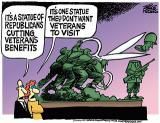The new UW MIA Recovery and Identification Project is thought to be the first of its kind launched by a university to help the Department of Defense
May 20, 2015 - A year after using cutting-edge DNA analysis to identify the remains of an American soldier mistakenly buried with the enemy after World War II, the University of Wisconsin-Madison announced Wednesday it will put its expertise in history, archaeology and forensic and genetic analysis behind the U.S. government's tedious efforts to identify and recover other missing service members.
The new UW MIA Recovery and Identification Project is thought to be the first of its kind launched by a university to help the Department of Defense, which spends about $2.5 million per service member identification, and makes an average of 74 identifications per year.
The search for Army Private First Class Lawrence S. Gordon, the American soldier mistakenly buried in a German cemetery, cost a team of civilian researchers about 1% of what the government spends, and required about two years of digging through decades-old military records, according to Middleton filmmaker Jed Henry, who led the civilian team and created a documentary about the effort.
Henry began the search for Gordon after finding out he was the only member of his grandfather's Reconnaissance Company who died in battle but never was identified and given a proper burial.
Recovering and identifying Gordon's remains cost about $25,000 — mostly for travel, Henry said.
"We could probably identify another 3,000 to 4,000 unknowns for half of that — $12,500," Henry said Wednesday, referring to the potential of the UW MIA Recovery and Identification Project. read more>>>























No comments:
Post a Comment